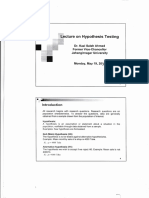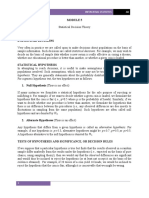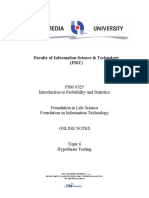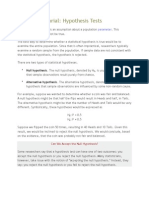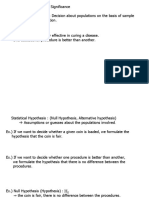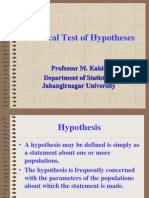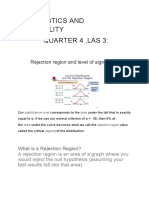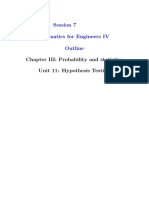0 ratings0% found this document useful (0 votes) 24 views10 pagesTesting of Hypothesis Notes
Copyright
© © All Rights Reserved
We take content rights seriously. If you suspect this is your content,
claim it here.
Available Formats
Download as PDF or read online on Scribd
Siete
isa function of the population values: It isa statistical
d from the population. For example. population mean is
ction of the sample values is & sample statistic, It is @
derived from the sample, For example sample mean
sures obtained from population are population parameters
‘obtained from sample are sample statistics
‘objective of sample study is to draw inferences (or
bout the population by examining, only a part of the popu-
¢ inferences drawn are called statistical inferences. Statisti-
yce is therefore a process by which we draw conclusions about
n based on samples drawn from that population.
es of statistical inference are:
2. Estimation
(Statistical tests)
test of hypothesis is a process or procedure under which
is is laid down and it is accepted or rejected on the
testing hypothesis: Pelehuiskhp bln owe ly
followed in a test of hypothesis are '
‘a null hypothesis (Hp) and an alternative hypothesi
priate to the test to be conducted, ea
> the appropriate test criterion (such as Z - test, t-test, x?
test ete.)
level of significance desired. Usually level of signifi
m : icance
is 5% (or 1%). Determine suitable level ctaathanet In
ce of any specific instruction, it should be normally 5
the value of the tes! statistic using appropriate fe ly 5%:�Pz
Wwe OF the test statistic corresponding to the
in the able VAN
‘Then obtain the deg
of freedom,
aed of sgnfcnnet accepting oF rejecting the null hypothesis The
6. Make a ‘on whether he computed value of the test Statistic
decision
|
} 5
3 inthe acceptance region OF Tejection region. When the compu-
: fallsin
isic is numerically less than the table val
of the test statis a
ieee statistic it falisinthe acceptance region, Otherwise in the
o a
3 rejection region.
“the sample is drawn from a normal
D = 10" is a hypothesis.
oF composite. If'a hypothesis is con-
ly such as functional form and the pa.
sis. Ifa hypothesis is not simple, then
‘xample: the hypothesis “Population is
E10" isa simple hypothesis while the
ormal distribution with ‘Mean = 25” isa
hypotheses
only the parameters of the Probability
tric hypothesis. Ifa hypothesis speci-
ction in the Population, it is called a
ample: the hypothesis “Mean of the
hile the hypothesis “population is nor-
as alternative hypothesis.
epee by My 9) Js opie ots
Hed 4 Canditited en'tp cd
delat & aie rf�P3
The Null hypothesis is de:
Noted by Hy and the Alternative hypoth-
1: é
For example: When we want to test whether the population mean is 65
the null hypothesis is “Population Mean is 65’ and alternative hypothesis
is ‘population mean is not 65°
Test Statistic
The decision to accept or to reject the mull hypothesis is made on
the basis of a statistic com 0
puted from the sample. Such a statistic is
called test statistic. It follows a sampling distribution. The commonly
used test statistics are t, Z, F, x2 etc. ‘
Sampling distributions
Select a number of random samples of defnite size from a
population and calculate some statistic, from each of these samples.
find they are different in value. So sample statistic is a variable and
therefore it should have a distribution The distribution thus obtained
for a sample statistic is called a sampling distribution. It is a probability
distribution. :
A sample statistic is random variable and it has a probability distri-
bution, called sampling distribution of that statistic.
Sampling distribution of sample mean
Sample mean is a random variable, as it changes from one sample
to another with a particular probability. Therefore sample mean has a
probability distribution known as sampling distribution of sample mean.
Mean and SD of such a sampling distribution (when the sample is large)
are respectively 1 and & where |! is the population mean and o isthe
Population standard deviation and ‘n’ isthe size of the sample.
Standard Error ae : :
1¢ standard deviation of a sampling distribution of a statistic is
standard error (SE) of that
For example: Standard deviation of the sampling distribution of the
sample mean is o/ vn where o is the population SD andn is the sample
size. Therefore SE of Sample mean = &/ va
call
ae +
Uses of Standard Error: Standard e1tor Plays a very important role in
the large sample theory and forms the basis of the testing of hypothesis.
(1) 6 Bis used ing a given hypothesis,
n about the reliability of a sample. The reciprocal
of S.E is a measure of reliability of the sample, :
(3) S.E can be used to determine the Confidence limits for population
values like mean, proportion and standard deviation,�P.4
Difference between Standard deviation and Standard error.
1. Standard deviation is a measure of dispersion of statistical data (or
a probability istribution). Standard error is a measure of dispersion
of a sampling distribution.
Standard deviation measures the variability or consistency of a sta-
tistical series. Standard error determines the precisious or reliabil-
ity of an estimated value.
3, Standard deviation is calculated in relation to the mean of a series
Standard error ean be calculated in relation to Mean, Median, S.D,
correlation coefficient etc.
4, Standard Deviation can be used to find out S. E. Standard error can
be used for estimation and testing of hypothesis.
Level of Significance ‘
mnfidence with which a null hypothesis is accepted or rejected
depends on what is called significant level. The probability with which
We may reject a null hypothesis, when it is true, is called the level of
significance. So when the level of significance is .05, it means that in the
long run the statistician is rejecting true null hypothesis 5 times out of
every 100 times. Therefore the level of significance is the risk, a statis-
tician is running in his decisions.
The level of significance is denoted by a.
Then, o. = Probability for rejecting Hy when it is true.
The level of significance is usually determined before conducting
the test of hypothesis.
Type I and Type Il errors
In any test of hypothesis the decision is to accept or to reject a null
hypothesis . The decision is based on the information supplied by the
sample data. The four possibilities of the decision are:
(1) Accepting a null hypothesis when it is true
2) Rejecting a null hypothesis when it is false
3) Rejecting a null hypothesis when it is true
_ 4) Accepting a null hypothesis when it is false.
Obviously (1) and (2) are correct while (3) and (4) are errors. The
Jast two cases are respectively known as type I and type ILerrors.
In the absence of the proper and adequate sample information it is
likely that errors may occur, Type | error is committed by rejecting null
hypothesis even when that hypothesis is true. Similarly type I] error is
committed by accepting a hypothesis when it is false.
Typelerror > Rejecting Hp When Ho is true.
Type error =} Accepting Hy when Hp is false.�1
For example: Suppose the test Conducted on the basis ofa sample drawn,
from the population leads to the Conclusion that population mean ¢ 125
even though population mean is 125, ‘This is type | error. Similarly on
the basis of the sample drawn, if the test conducted leads to the conclu-
sion that the population mean is 125 ev
en though population mean is not
125, it is type I error.
Degree of freedom.
Degree of freedom is defined as the number of independent obser-
vations which is obtained by Subtracting the number of constraints from
the total number of observations, * -
~~For example, int testing the population mean, suppose the test statis~
tic follows t-distribution, then de ¢ of freedom. 1
Critical Region
In atest procedure we calculate a test statistic on which we base our
decision. The range of variation of this Statistic is divided into two re-
gions, acceptance region and rejection region. Ifthe computed value of
the test statistic falls in the rejection region we reject the null hypothesis,
The rejection region is also known as critical region.
Critical region corresponds to a predetermined level of significance
(say ct) and the acceptance region corresponds to the region, 1 — a.
Size of the Critical region ‘
Probability for a selected sample to belong to the critical region is
called the size of the ciritical region. Therefore size of the critical region
=P [rejecting Hy when Hy is true).
“ ‘Size of the critical region is also known as level of significance.
Best Critical Region 3
While fixing the size of the cirtical region our aim is to minimise
both type I and type II errors. But decreasing one type of error causes
increase in the other type of error. This is undesirable, So we have to
keep the ciritical region as low as possible without allowing type Il error
to go up very much.
ere of hypothesis, we can think ofa number of critical regions
each haying same level of significance. Of all these critical regions that
which has least type II error is called best critical region,
‘Two tail jed tests
‘ i fled as in which We reject the null hypothesis if the
computed value of the test statistic is Significantly greater than ot lower
than the critical value of the test statistic. Thus in two tailed tests the
criticcal region is represented by both tails. Ifwe are testing hypothesis,�P.6
f signifience, the size of the acceptance region is 0.95 and
eee aa Se is 0.05 on both sides together. So if the
east a ce ecsui cite falls cither inithe left tail or in the right
ae ny poe hat the average height of people is 156m. Then the
rejection would be on both sides since the null hypothesis is rejected if
the average height in the sample is much more than 156 or much less
than 156. See the following diagram. The rejection region is marked in
left tail and in right tail.
acceptance region
SSS reliction resin =
In one tailed test, the rejection region will be located in only one
tail which may be either left or right, depending on the alternative hy-
‘acceptance region
Critical Value CTabje ;
The Value
fomikeyee "SS statistic which seperates the rejection region
level of significance gs called the critical value, It depends on the
When 2? test is alternative hypothesis. 3
bution) the Critical (ie the test statistic follows normal distri-
MME orGitrerent levels of significance ere
Lt...�P.7
Critical Value
Level of significance Two tailed One tailed
1% 2.58 2.33
5%
1.96 1.645
When the calculated value of the test statistic is numerically less
than the critical value, we accept the null hypothesis
Significant difference
Ifthe difference between a sample statistic and the corresponding
Population parameter is attributable only to sample fluctuations, we say
the difference is not significant. Otherwise the difference is significant.
When the difference is not significant, we conclude that the sample sta-
tistic and population parameter are equal.
Power of a test
Probability for rejecting the null hypothesis when the alternative
hypothesis is true is called power of a test.
. Power of a test = 1 —P {type If error]
Most Powerful test
‘The test based on the most powerful critical region is called most
powerful test.
Neyman - Pearson Lemma
For a given hypothesis, any number of tests can be suggested. The
best of them is that for which level of significance is less than a preas-
signed small number and the power is maximum,
Therefore according to Neyman-Pearson, a level of significance
should be fixed. Then consider all tests whose level of significance is
less than this. Of these tests, select that which has the maximum power.
Such a test is called most powerful test.
Large Sample and Small Sample tests
Itis difficult to draw a clear - cut line of demarcation between large
and small samples. It is generally agreed among statisticians that a sample
is to be considered large if its size exceeds 30.
The statistical tests used for large samples are different from those
used for small samples since the assumptions made in
samples are not true for small samples.
For large samples the sampling distribItion of the test statistic is
normal distribution and therefore the statistical test applied is Z - test.
For small samples, the sampling distribution of the test statistic may
be (1) Normal distribution (2) t - distribution (3) %2 distribution (4) F -
distribution. Therefore in the case of small samples statistical test ap-
plied may be Z-test, t-test, X2-test, F-test etc.
Weshall discuss in this chapter problems based on Z - test and t-test.
the case of large
=�Z-test
the test sta iG
Z.-test is applied when the test statistic follows no
ees i ae population mean when the sample is large or when
the population SD is known.
2, To test the equality of two sample means when the samples are large
or when the population SD is known,
3. Totest the population proportion.
C4, To test the equality of two sample proportions.
5b
6.
distribution
To test the population SD wien the sample is large.
To test the equality of two sample standard deviations when the
samples are large or when population standard deviations are known.
7. Totest the equality of correlation coefficients.
& Assumptions in Z - test are:
1) Sampling distribution of test statistic is normal.
2) Sample statistics are close to the population parameter and there-
fore for finding standard error, sample statistics are used in places where
E population parameters are to be used.
i t-test
t-test is applied when test statistic follows t - distribution.
Applications (uses) of t - test are:
1. To test the given population mean when the sample is small and the
‘4 population S. D is not known.
4 2. Totest the equality of two sample means when the samples are small
a and population S. D is unknown.
Y : To test the difference in values of two dependent samples.
_ Totest the significance of Correlation Coefficients.
Assumptions in ‘t” test —
Bd rent population from which the sample drawn is normal
anne O lions are independent.
the ©.) “9” is unknown.
two population means is tested, the samples
ean Y A. ie and the population variances are
& dual and unknown.
This tet RO THE GIVEN ROPULATION MEAN /"
true. That is, een test whether the given population mean is
va the difference between sample mean and
“ihifcan, or it is only due to sampling fluctuations.
Z
i
:�Ro ae Ee
For this type of problems we can apply Z-test or t-test. The detailed test
procedure is explained below,
1. First ofall set the hypothesis that there is no significant difference K! "ry,
between sample mean and Population mean. That is the given popu-
{ation mean is true. This can also be expressed as = Ho. Here Hy
stands for the numerical value o
f population mean, given.
2. Secondly decide the test criter}
ion. If the sample is large,the test is |
Z-test. If the sample is small but population S.D is known, the test
Seas -
is again Z-test. If the samy
ple is small and population S.D is not known
the test applied is t - test,
. Xa nia.
= . Here
3. Using the formula Standard error Compute the test statistic. Hi
X isthe sample mean and Ho isthe population mean. |
Standard error is computed by one of the following formulae:
(ar Iwhen population 8. Dis known and sample is small or large]
(i) + [when population SD is not known and sample is large]
iii) JS (when population S. D is not known and sample is small].
© , Sand nare respectively population S.D, sample S. D and sample
size.
4.
ze
For Z-test, the degree of freedom is infinity while for t-test it is n—1.
Then get the table value of the test statistic, for the degree of freedom
and level of significance :
(the level of significance is usually predetermined and stated.)
6. Finally take a decision either to accept or to reject the hypothesis
oringinlly set in step I. When the calculated value of test statistic as
Per step 3 is numerically less than the table value, we accept the
hypothesis. Otherwise reject it.
Sa
PROBLEMS 9 ato! 1
Ex. 1: Itis claimed that a random sample of f 100 tyres with mean life
©f 15269 km. is drawn from a population of tyres which has a mean
life of 15200 km and SD of 1248 km. Test the validity of the claim,
Ans: Null hypothesis (Hg): = 15200 Ont
en
Since sample is large, apply Z test eo
Test statistic, Z= X=
8
= 124 i)
and SE= Se * “ftir = 124.8
where X= 15269, 1 = 15200 —�






